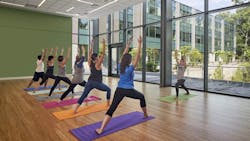Design for Wellness – Evoking Beauty, Nature and Welcome
Today, design for healthcare is at a pivotal moment.
When it was built, Duke Integrative Medicine, a part of Duke Health, was a pioneering program that required innovative design thinking. The state-of-the-art facility is considered the first designed solely to unite traditional, complementary and alternative medicine into a new model of holistic healthcare. Its design integrated natural elements such as wood and stone, framed views of nature, multi-function spaces, and carefully choreographed patient circulation with more traditional spaces for clinical care.
Every architectural element contributes to subtly heighten awareness for users and visitors and to present an alternative to typical healthcare design—a human-centric interweaving of natural and manmade—where patient experience and treatment carry equal importance.
That was over 12 years ago. Today, wellness has emerged as a key aspect of design for all types of buildings, even corporate headquarters and student centers. In part, this is an outcropping of green design initiatives that have put interior air quality, the influence of daylight on occupant well-being, and access to fresh air and views at the forefront of the conversation around design.
What was new and unique is that Integrative Medicine has become the inspiration for facilities such:
- The Center for Health & Wellbeing in Winter Park, FL: An innovative, landmark healthy living center with the goal to unite the realms of wholeness, fitness and medicine into a single integrated center.
- Duke University’s new Student Wellness Center: With the goal being to bring student health out of the age of infirmaries and demonstrates how to facilitate HIPAA requirements with openness, beauty and light.
They share common features that expand and give new meaning to many of the strategies used in Integrative Medicine.
Bridging Nature in Wellness Design
The entry atrium establishes connections to nature through its wooden super structure, framed views, clerestory lighting, loose river rock garden, and natural flooring and paving materials. Veneered surfaces use site-harvested, locally-milled oak, and massive, site-harvested timbers were minimally milled for bench seating. A contemplative garden focuses on Duke’s Anderson Forest, reinforcing connections to nature.
Additional features include:
- A translucent wall etched with a pattern of leaves, rises next to the building’s connecting stair
- A wood feature wall is embedded with information screens
- Randomly distributed acrylic panels—screen printed with images taken of the original site and etched with quotes from spiritual philosophers—punctuate all building levels
- On the ground floor, graphics represent an eye-level forest view that rises through a stand of trees to the top level, where the pattern of branches and sky reflects the forest canopy
The architecture for the Center for Health & Wellbeing draws inspiration from the healing power of nature through proportion and scale. The golden ratio's height to width proportions recurs in nature, art and architecture and provides a subtle ordering system that’s comfortable and easily understood. The ratio was used for the size and pattern of the central Commons’ structural bays, defined the size of the adjoining terrace, and informed the mullion and frit patterning in the entrance and exterior facades.
Listen to I Hear Design with your Favorite AppsBuilding Information Modeling software allowed to ensure this approach to proportion was maintained throughout. The number seven also occurs in the natural world and is represented across the Center, starting with seven Dimensions of Wellness:
- Physical
- Emotional
- Intellectual
- Social
- Spiritual
- Vocational
- Environmental
Seven gardens support meditation, contemplation and reflective walking; and include patches of herbs and vegetables. The Center’s seventh garden is the iconic, community-centric welcoming Commons, which includes a dynamic, undulating ceiling derived from extending the ratio through the sine curve.
Beyond Nature
Another commonality between these buildings is the combining of functions in new ways to create a cross-disciplinary, wellness-focused culture. Spaces for nutrition education, movement/yoga classes, collaboration and meditation are located nearby more private spaces for counseling, clinical care, pharmacies and immunizations. Different clinical departments and functions are merged around shared resource, meeting and office spaces. Multipurpose spaces expand cross-disciplinary thinking and sharing to include outside sources.
Duke envisioned better student outcomes would also come from an improved staff work experience, reversing a trend for clinics to be tucked away from natural light and views. Research substantiates the positive impact physically and psychologically supportive environments have on employee stress and fatigue.
Welcoming In
A predominant theme in both projects, and any project that seeks to promote wellness, is to be welcoming. The heart of the Center for Health & Wellbeing is the light-filled central Commons, which provides the community with an open, flexible, multipurpose space for events and socializing.
For Duke, they wanted to create an environment that welcomes students and provides a comfortable place while encouraging healthy behaviors. The two-story entry pavilion was critical to answering that vision. Conceived as an open multistory living room the sunlight, views, screening and natural materials bring the exterior ecology inside. In doing so, it can be seen and felt by users, without sacrificing the privacy required by the various program functions. In both buildings, these spaces serve as orienting points for building programs and become the building’s first interior expression of welcome.
For both these projects, interior and exterior public space was essential. For Winter Park’s Center for Health & Wellbeing, this begins in the gardens and extends to the Commons. For Duke Student Wellness, in addition to a ground-level plaza, the atrium lobby has been included on a student list of top 10 places to study. These spaces allow new facilities to welcome their communities, making them vital contributors to fostering a culture of wellness for all.
Improving Outcomes
Data collected at Duke Student Wellness indicate the theories utilized in the building’s design are having the desired outcomes:
- Increases in walk-ins from 3 to 63 walk-ins in its first year
- 28 percent increase in the use of counseling services
- Attendance at wellness programs up by 40 percent
- Care appointments increasing 6 percent with no-shows decreased 10 percent
The Center for Health & Wellbeing is currently under construction. This state-of-the-art healthy living center will focus on improving the quality of life for residents of Winter Park and surrounding areas by offering a wide variety of services and educational programs to help empower members of the community to be healthier and full of vitality. It is scheduled to open February 2019.
Duke’s successful results and the individual and community benefits these buildings bring to their communities’ present specific design strategies—integrating nature and light, welcoming occupation and creating new collaborations—that designers can utilize to positively and holistically influence our collective health and wellness.
► Daily Design News | Revamped PlayPark at SickKids Hospital




